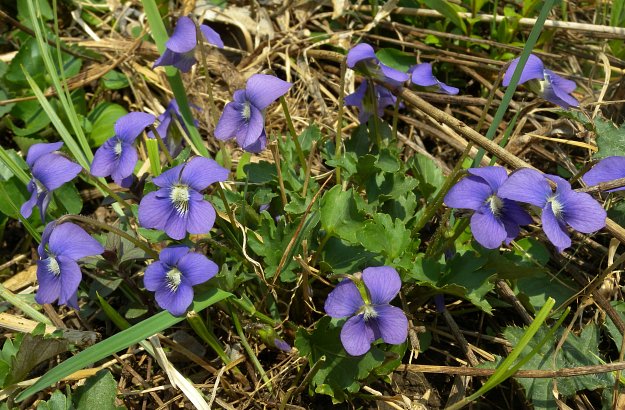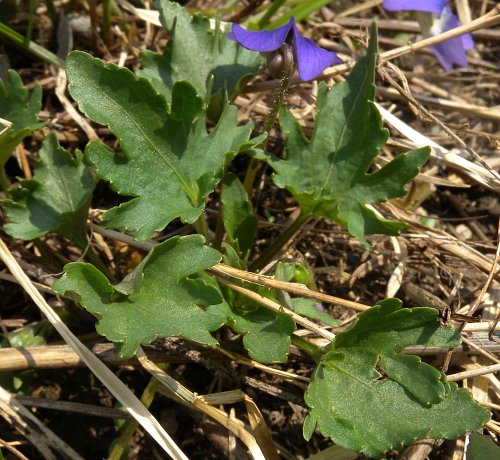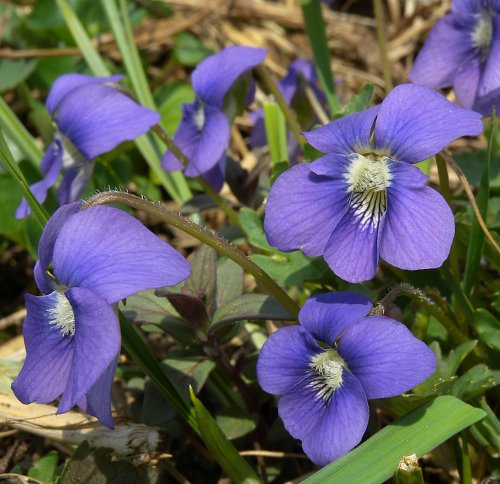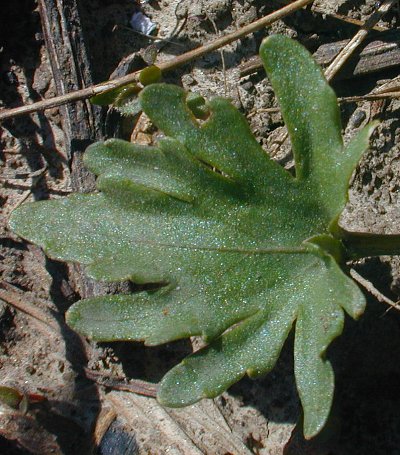Description: This perennial wildflower consists of a low rosette of basal leaves spanning about 4-6" across, from which stalks of flowers develop directly from the crown. The blades of the basal leaves are up to 2½" long and across; for var. dilatata, they are usually divided into 5-7 palmate lobes. These lobes are finger-like in shape, somewhat variable in size, and extend up to half-way into the blade. Some of the larger lobes may be subdivided into smaller lobes, and the margins of the leaf blade may have a few dentate teeth. The upper surface of each leaf blade is medium to dark green and hairless, while the lower surface is light green and hairy along the veins. The petiole of each leaf is about as long as the blade and rather stout; it is conspicuously hairy on the lower side. Individual flowers about ¾–1" across are borne at the apex of ascending stalks that are as long or longer than the leaves.

Each flower has 5 spreading petals that are deep blue-violet (2 upper, 2 lateral, and 1 lower), and 5 sepals that are light green to purple. The 2 lateral petals have dense white hairs (or beards) near the throat of the flower, while the lower petal has a conspicuous patch of white with blue-violet veins. These petals converge into a short nectar spur that is surrounded by the sepals. The sepals are lanceolate-ovate and pubescent. The stalk of each flower is densely covered with spreading white hairs; it is light green to deep purple, and nods downward at the apex where the flower occurs. The blooming period occurs during mid-spring to late spring and lasts about 2-3 weeks. During the summer, inconspicuous flowers are produced that are self-fertile; they are not pollinated by insects, unlike the spring flowers. Each fertile flower is replaced by an oblongoid capsule containing many small brown seeds. When it is ripe, this capsule divides into 3 parts, mechanically ejecting the seeds several inches or feet from the mother plant. The rootstock consists of a short stout crown with fibrous roots underneath.

Cultivation:
The
preference is dappled sunlight during the spring, followed by partial
sun or light shade during the summer. The basal leaves die down during
the fall. The soil should contain some loam and be well-drained; some
rocky or gritty material is also tolerated. This plant dislikes
competition from taller ground vegetation.
Range & Habitat:
This variety of Cleft Violet is uncommon in the southern two-thirds of
Illinois, while in the rest of the state it is rare or absent (see Distribution
Map). Local populations tend to be widely scattered from each
other. Habitats include dry rocky woodlands, wooded upper slopes, and
thinly wooded bluffs. Oak trees are often present at these habitats.
The Cleft Violet is normally found in higher quality woodlands where
the original ground flora is intact.

Faunal
Associations:
The flower nectar of violets attracts various bees (Andrenid bees,
Mason bees, etc.), bee flies (Bombylius spp.),
butterflies, and skippers. The caterpillars of several Fritillary
butterflies and miscellaneous moths feed on the foliage of violets (see
the Butterfly
& Moth Table), as do the caterpillars of Ametastegia
pallipes (Violet Sawfly), which skeletonize the leaves. The
insect Odontothrips pictipennis (Thrips sp.) sucks
juices from violets. The leaves and stems of violets are eaten to a
limited extent by the Cottontail Rabbit, Eastern Chipmunk, Wild Turkey,
and Ruffed Grouse; the seeds are eaten by the Slate-Colored Junco.
Photographic Location:
The wildflower garden of the webmaster in Urbana, Illinois.

Comments: This variety of Cleft Violet is one of several violets with lobed leaves. In general, it is less deeply lobed than Viola pedata (Bird's Foot Violet) and Viola pedatifida (Prairie Violet), but more strongly lobed than Viola sagittata (Arrow-Leaved Violet) and Viola fimbriatula (Sand Violet). Even for a single plant of Cleft Violet, there can be significant variation on the number of lobes and their depth for each leaf. The flowers of this species are quite similar in appearance to those of other violets with blue-violet petals. Other common names of Viola palmata are Early Blue Violet and Blue Wood Violet. A scientific synonym for this species is Viola triloba dilatata. Where their ranges overlap, this variety of Cleft Violet may intergrade with the typical variety; the latter has fewer lobes on its leaves (usually 3 or none).